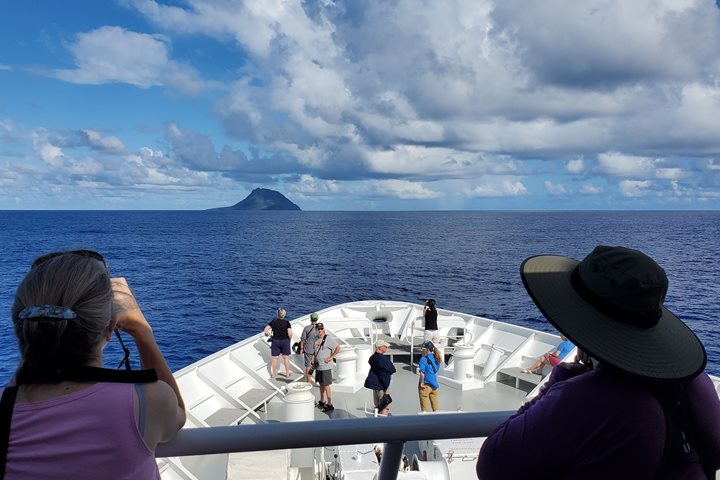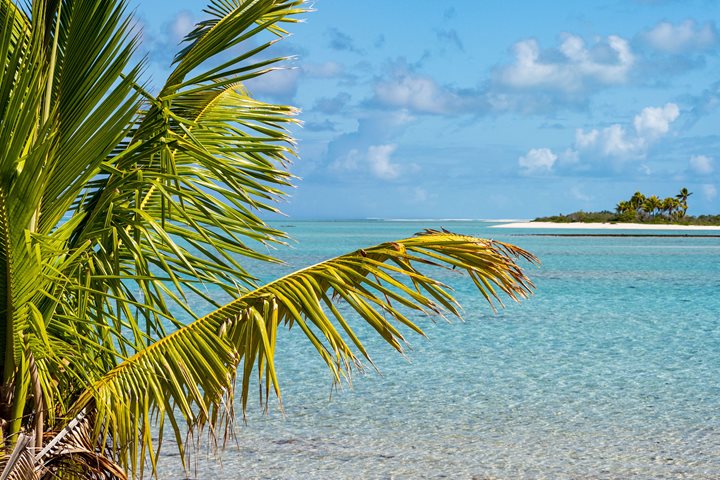You know it is going to be a special day when your wakeup call includes the following: "Dolphins on the bow." And there they were, about a dozen, enjoying the push of the water displacement provided by National Geographic Orion as it plowed through the Pacific waters. Five of them lined up together, looking to me like a troop of dainty synchronized swimmers out of a Busby Berkeley musical. There's nothing better than watching these ballet dancers of the sea perform their acrobatic moves, all while holding a fresh latté from the lounge cafe in your hands.
Or at least that's what I thought until an even more transcendent moment took place later that afternoon. We spent our afternoon on the southeastern corner of the French Polynesian island of Raiatea. A more picturesque location would be hard to imagine. We anchored equidistant between two icons of spiritualty in Polynesia.
The first was one of the best surviving and most important maraes in the whole of Polynesia. Taputapuatea is a UNESCO World Heritage site that once played a central role in pre-Christian life in the islands. It was the epicenter of the powerful Oru cult, whose priests conducted many ceremonies on the site, and any sailor wishing to travel to the far ends of Polynesia had to pass by the site to gain permission from the gods. Just a few years before the arrival of Captain James Cook in the region, the marae was destroyed by warriors from Bora Bora, who were jealous of the cult's power.
The other icon of spirituality was a pale yellow Protestant church, whose bell tower rose just a few hundred yards down the coastline. With striking lush volcanic mountains rising behind, it was an impressive site and representative of the Pacific's dramatic shift to Christianity after the arrival of missionaries beginning at the turn of the 18th and 19th Centuries. Today, almost every Polynesian is Christian, although every denomination can be found across the islands, from to Adventist to Catholic, Mormon to Methodist.
Before arriving in Polynesia, I longed to hear the famous sounds of a Tahitian church choir in person, as its unique harmonies and melodies are famous among ethnomusicologists. Prior to arriving in Raiatea, I had arranged with the local church to have their members come down in their Sunday best and perform a few songs for us. Despite the fact that it was a workday and in the middle of the afternoon, nearly 100 parishioners turned up to welcome us.
The church was built between 1953 and 1962, and featured a high wooden ceiling and resonant acoustics. The moment the group began to sing such a beautiful sound filled the room that is was hard to keep tears coming from my eyes. Many among us didn't even try and the deep emotion of the moment was deeply moving. The group performed two styles of himine, or Tahitian hymns; the energetic tarava and the more languid ru'au. Each featured unique, rich harmonies and vocal lines that wove in and out of each other like a pod of dolphins. There was no sheet music, only hand written hymnals with the words to the songs in the Tahitian language. The harmonies were invented naturally on the spot and not a more beautiful sound could be imagined.
The time flew by and soon we said our goodbyes to the smiling members of the church. A local reporter was on hand to document the event, as it proved to be the first time any tourists had ever asked them to demonstrate their singing. All who were there felt that we were part of a special moment, and it was something I will personally always cherish.
As the sun set over the mountains, we returned to the ship and sailed through the reef towards our night's anchorage, images of dolphins and soulful melodies swimming through our heads.







